
February 7, 2009
“Yamapikarya” – Part II
Guest Blog by Brent Swancer
In Part One, I introduced the “Yamapikarya,” a mystery cat on Japan’s Iriomote island.
In part 2, let’s look at some the possibilities for what this cryptid could be other than domestic cats or dogs.
Some have proposed that the Yamapikariya is merely misidentified wild boars that have been seen. I actually find this explanation to be fairly silly. Not only do wild boars look nothing like a large cat, but the coloring is also way off, and they don’t climb trees.
It must also be remembered that many of the sightings of the Yamapikariya have been made by hunters, indeed wild boar hunters no less, who got a good look at the animal in question. It seems fairly unlikely that a wild boar hunter would mistake a wild boar for a large spotted cat. I highly doubt this is the case, so what else could the Yamapikarya be?

One possibility is that what is being seen is a leopard (Panthera pardus), above. While many people may think of Africa when they think of leopards, these cats actually have the widest distribution of any wild cat, and are found in eastern and southeastern Asia as well. Leopards are also very robust and adaptable, inhabiting a wide range of habitats from grassland to jungle, and could likely do quite well on Iriomote. Their black rosette marked coat and fairly stocky build are a perfect match for the Yamapikariya.
Some sightings of the Yamapikariya have also been made in trees, including sightings by people who mention being astonished by the speed and agility with which the cat can climb. This would fit well with a leopard as they are known for their climbing prowess and resting or feeding in trees. At typical sizes of 1.3 to 1.9 meters (around 4 to 6 feet) long with a tail 3 to 4 feet long, the leopard tends to be a bit on the large side for what is reported for the Yamapikariya, but it is still worth considering.
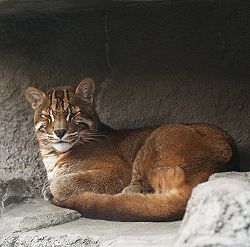
It also seems vaguely possible that we could be dealing with another cat native to Asia, the Asian golden cat (Padofelis temminickii). At a tad less than a meter long, the size is somewhat comparable to the Yamapikarya, and although the golden cat typically has a mostly plain golden coat with limited or faded spots, there is a recessive color variant in China that exhibits very leopard like markings similar to a leopard cat.
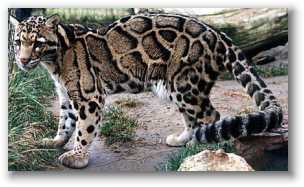
One animal that is perhaps the best candidate for the Yamapikariya is the clouded leopard (Neofelis nebulosa) – directly above and below – of Asia. These cats are not really a type of leopard, but rather are named for their coloration, which is a grayish, yellow, or yellowish grey, with cloud shaped black spots covering the body.
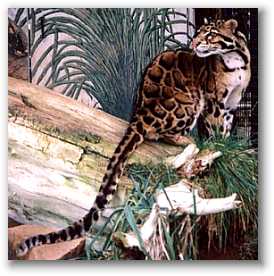
This seems very similar to the coloration that has been reported by eyewitnesses of Iriomote’s Yamapikarya, and the cloud shaped spots could produce the report that described the spots as “oddly shaped.” The Clouded leopard ranges in size from about 2 to 3 feet long, not including the additional length of the tail, which at 2 or 3 feet long is the same length as the body. This size range and the long tail coincides well with what has been described in Yamapikarya sightings. Since the clouded leopard is a highly arboreal animal and considered one of the best climbers in the cat family, it also fits in well with the reports of the animal in trees or climbing.
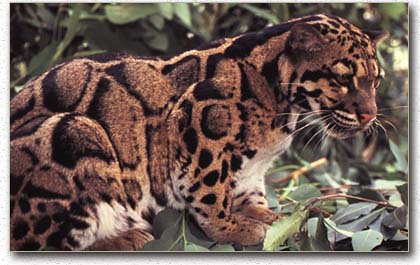
In addition to these physical traits, the range of the clouded leopard covers Eastern and Southeast Asia, including a subspecies in nearby Taiwan (Neofelis nebulosa prachyurus), which is now extinct in the wild. In fact, much of the range of the clouded leopard overlaps that of the smaller leopard cats, which are related to the known Iriomote wildcat.
Since the Iriomote wildcat (above) evolved from leopard cats that became isolated on the the island long ago, it seems not too far a jump to suggest that perhaps clouded leopards in the same range could have inhabited the island as well. The subtropical habitat on Iriomote would be also be very comfortable indeed for these cats, since prey species are abundant and clouded leopards tend to prefer tropical and subtropical forests, as well as mangrove swamps.
The clouded leopard is also an extremely elusive and secretive animal, that is rarely seen even in its known habitat. These cats are so reclusive that they are still little understood, and much of what is known about them has been gleaned from observing captive specimens. They are a good candidate if you are looking for a cat that could remain undiscovered on Iriomote.
This brings us to the question of whether a population of any of these cats could really remain hidden on this island.
Although Iriomote Island sounds small at only 113 square miles in area, much of it is completely uninhabited. There are only around 2,000 permanent residents on the island, who are settled in the coastal areas. Infrastructure is poor, with no airstrip (the island is only accessible by boat), and only one main road, which wraps around the coast to connect the various villages. The interior of the island is thick with primeval subtropical jungle and mangrove swamps so dense as to be practically impenetrable and inaccessible by humans, with no roads and few trails.
It is important to consider that the known wildcat is almost never seen even by long term residents, if at all, even though the cats tend to favor low lying coastal areas where the bulk of the island’s human population live. The Yamapikarya could very possibly be lurking more in the mountainous inland regions well away from humans. Also like the known Iriomote wildcat, the clouded leopard and leopard are predominantly nocturnal and well camouflaged, which when taken together with the remote, impassable jungle habitat, makes it seem at least plausible that a small population could remain concealed on the island.
If the Yamapikarya is indeed one of these cats, it is likely that in their long isolation the cats have evolved uniquely on the island much as the Iriomote wildcat did, making it very possible that it could be an entire new species within its genus, or at the very least a new subspecies. It could very well be that whatever type of cat it is, it could be another animal found only on Iriomote and nowhere else in the world.
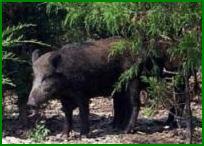
Unfortunately at this point, no physical evidence of the Yamapikarya has been found, but the mystery remains. Something has been seen on the island that does not match with other animals known to be there. Is it a new type of clouded leopard, leopard, or golden cat? Could it even be a new genus of cat? Is it some other type of large cat, an exotic, even perhaps some type of presumably extinct prehistoric cat? Is it a wild boar, a feral cat, or a dog? Or is it perhaps just a figment of people’s imaginations?
The answer to these questions could be out there right now, prowling the jungles of Iriomote Island.
End of Part 2.

About Loren Coleman
Loren Coleman is one of the world’s leading cryptozoologists, some say “the” leading living cryptozoologist. Certainly, he is acknowledged as the current living American researcher and writer who has most popularized cryptozoology in the late 20th and early 21st centuries.
Starting his fieldwork and investigations in 1960, after traveling and trekking extensively in pursuit of cryptozoological mysteries, Coleman began writing to share his experiences in 1969. An honorary member of Ivan T. Sanderson’s Society for the Investigation of the Unexplained in the 1970s, Coleman has been bestowed with similar honorary memberships of the North Idaho College Cryptozoology Club in 1983, and in subsequent years, that of the British Columbia Scientific Cryptozoology Club, CryptoSafari International, and other international organizations. He was also a Life Member and Benefactor of the International Society of Cryptozoology (now-defunct).
Loren Coleman’s daily blog, as a member of the Cryptomundo Team, served as an ongoing avenue of communication for the ever-growing body of cryptozoo news from 2005 through 2013. He returned as an infrequent contributor beginning Halloween week of 2015.
Coleman is the founder in 2003, and current director of the International Cryptozoology Museum in Portland, Maine.
Filed under Alien Big Cats, Cryptid Canids, Cryptomundo Exclusive, Cryptotourism, CryptoZoo News, Guest Blog, Mystery Cats